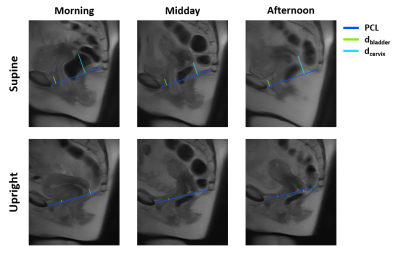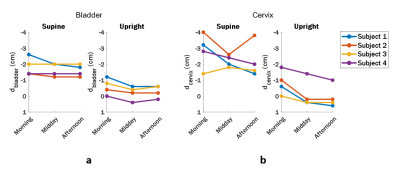Lisan M. Morsinkhof1, Anique T.M. Grob2, Angelique L. Veenstra van Nieuwenhoven3, and Frank F.J. Simonis1
1Magnetic Detection & Imaging, TechMed Centre, University of Twente, Enschede, Netherlands, 2Multi-Modality Medical Imaging, TechMed Centre, University of Twente, Enschede, Netherlands, 3Department of Gynecology, Ziekenhuisgroep Twente, Almelo/Hengelo, Netherlands
1Magnetic Detection & Imaging, TechMed Centre, University of Twente, Enschede, Netherlands, 2Multi-Modality Medical Imaging, TechMed Centre, University of Twente, Enschede, Netherlands, 3Department of Gynecology, Ziekenhuisgroep Twente, Almelo/Hengelo, Netherlands
The cervix of women
without symptomatic pelvic organ prolapse (POP) descended during the day and this effect was larger in upright position. This will be compared to
patients with symptomatic POP. An effect of daily variation is relevant in POP
staging, used in deciding the optimal POP treatment.

Figure 1 Sagittal FSE images of one
subject at different moments during the day in supine and upright position, on
which the measured distances of the bladder and cervix to the pubococcygeal
line (dbladder and dcervix respectively) are visualized.
dbladder is comparable over different measurements during the day in
both supine and upright position. dcervix is also comparable during
the day in supine position, but in upright position a descent is visible,
mainly between the morning and midday measurements.

Figure 2 Measured distances of the
bladder and cervix to the pubococcygeal line (dbladder and dcervix
respectively) at different moments during the day in supine and upright
position. a) There seems to be a small descent of the bladder during the day.
This descent is comparable between supine and upright position. b) The cervix
descends during the day. This descent is larger in upright position than in
supine.
